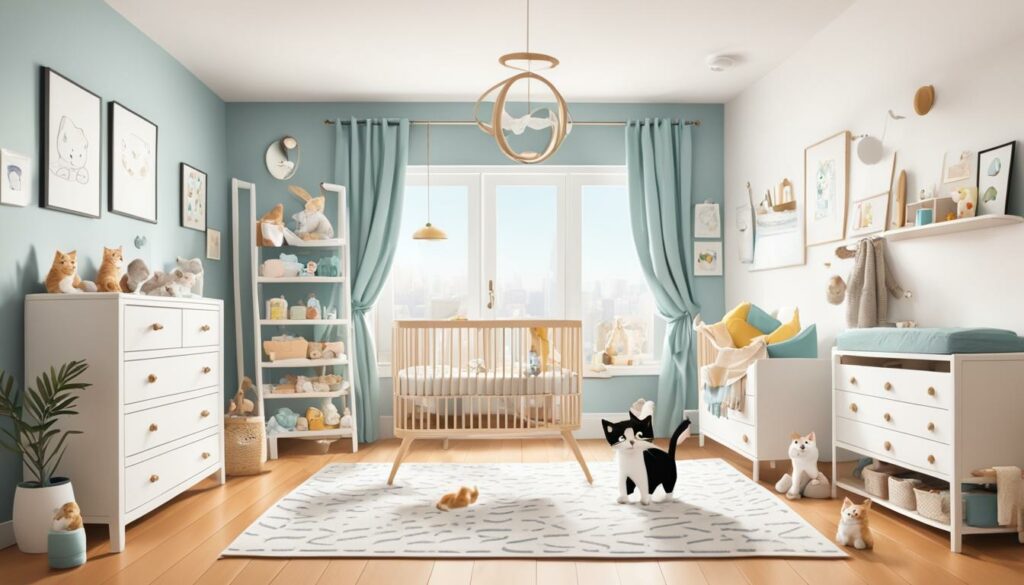Introducing a new baby to your feline friend can be a source of concern for new or expecting parents. While it’s natural to worry about how your cat will adapt to the new addition to the family, with proper precautions and careful planning, cats and babies can coexist happily. By taking the necessary steps to ensure the safety of both your baby and your cat, you can create a harmonious home environment for everyone involved.
When considering bringing a cat into a household with a baby, it’s important to take into account the unique dynamics between pets and newborns. Understanding cat behavior around infants and implementing appropriate measures can help foster a positive relationship between your cat and your baby.
Key Takeaways:
- Gradually prepare your cat for the arrival of the baby by creating positive associations with baby-related sounds and smells.
- Keep the cat indoors to prevent the transmission of diseases and ensure the safety of both the baby and the cat.
- Establish boundaries and provide a safe space for your cat, especially when the baby is sleeping.
- Supervise all interactions between your cat and your baby to prevent any potential accidents or injuries.
- Consider the responsibilities and costs associated with cat ownership before getting a cat with a baby.
Preparing for Your Baby’s Arrival
As you prepare for the arrival of your baby, it’s important to include your furry friend in the process. Preparing your cat for the new addition to the family can help ensure a smooth transition and create a harmonious environment for everyone. Here are some steps to take to make the preparation process easier:
Maintain Indoor Living
To protect your cat from potential diseases and parasites, it’s essential to keep them indoors. This helps prevent exposure to harmful substances and reduces the risk of contracting toxoplasmosis, a parasitic infection that can be dangerous for pregnant women and their unborn babies.
Reduce Toxoplasmosis Risk
Pregnant women should be cautious when it comes to interacting with cats, especially those from the neighborhood. Toxoplasmosis can be transmitted through cat feces, so it’s important to avoid handling litter boxes. If you must clean the litter box, wear gloves and wash your hands thoroughly afterward. You can also delegate this task to a partner or a family member.
Gradually Introduce Baby Noises and Smells
Help your cat get accustomed to the sounds of a baby by playing tapes of baby noises. This gradual exposure can help prevent anxiety or stress when the real baby arrives. Additionally, introduce your cat to the smells associated with the baby, such as baby lotion or powder, so they can start forming positive associations.
Relocate the Litter Box and Cat Care Routines
Prior to the baby’s arrival, gradually move the litter box to its designated location, ensuring it’s in a space separate from the nursery. Cats are creatures of habit, so making these changes gradually helps them adjust more easily. It’s also a good idea to shift any cat care routines, such as feeding and playtime, to a new caregiver, so your cat doesn’t associate them solely with you.
Creating a safe, positive, and comfortable environment for both your baby and your cat is essential in ensuring a harmonious coexistence. By taking these steps to prepare your cat for the arrival of your little one, you can set the stage for a happy and healthy family dynamic.
After Your Baby is Home
Bringing your newborn baby home from the hospital is an exciting and joyful time. However, it’s important to consider how to introduce your cat to the newest member of your family. By following a few guidelines, you can create a safe and harmonious environment for both your baby and your cat.
First and foremost, it’s essential to give your cat a quiet and stress-free introduction to the baby. Allow your cat to approach at their own pace, without any interruptions or sudden movements. Keeping the environment calm and serene will help your cat feel more comfortable and reduce the chances of any negative reactions.
Table: Tips for Introducing Your Cat to Your Newborn Baby
| Tip | Description |
|---|---|
| 1 | Keep the baby’s sleeping-locations off-limits to the cat |
| 2 | Ensure the nursery is closed or protected to prevent the cat from entering |
| 3 | Provide a separate, safe space for the cat, such as a designated room or area |
| 4 | Supervise all interactions between the cat and the baby |
Creating clear boundaries is crucial when it comes to your cat and your baby. Baby’s sleeping areas should be strictly off-limits to the cat to prevent any potential accidents or discomfort. The nursery can be protected by using a screen door or a crib tent, ensuring that your cat cannot enter the room unsupervised. Additionally, it’s important to supervise any interactions between your cat and your baby, especially during the early stages.
Providing a separate, safe space for your cat can also help alleviate any potential stress. This designated area should include all of your cat’s essentials, such as food, water, litter box, and a cozy bed. By having their own space, your cat can retreat to a familiar environment whenever they need some quiet time.
Remember, the safety of both your baby and your cat is paramount. By following these guidelines and providing a structured introduction, you can create a harmonious and loving environment for your entire family.
Making Gradual Changes
When preparing your cat for the arrival of a new baby, it’s important to make gradual changes to help them adjust smoothly to the new addition. By introducing baby-related stimuli in a controlled manner, you can help your cat become familiar with the sights, sounds, and smells associated with the baby.
Preparing cat for baby sounds
One way to acclimate your cat to the sounds of a baby is by playing recordings of baby noises. Start by playing the sounds at a low volume and gradually increase it over time. This will help your cat become accustomed to the noises and prevent them from being startled when the baby arrives.
Introducing baby smells to cat
Another way to help your cat adjust is by introducing them to the scents associated with the baby. You can do this by using a baby blanket or clothing item and gently rubbing it on your cat. This will transfer the baby’s smell onto the fabric, allowing your cat to become familiar with the scent before the baby arrives.
Baby and cat interaction
It’s important to teach your cat how to interact appropriately with the baby. Show your cat how to approach the baby gently and reward them for calm behavior. Supervision is key to ensure the safety of both the baby and the cat during their interactions.
By making these gradual changes and taking the time to help your cat adjust, you can create a harmonious environment for both your baby and your furry friend. Remember to always prioritize the safety of both the baby and the cat and seek professional advice if needed.

Considerations for Cat Ownership with Infants
Before considering cat ownership with infants, there are important factors to take into account. Owning a cat requires responsibility and commitment, especially when there is a baby in the house. Here are some considerations to keep in mind:
Responsibilities of Cat Ownership
Owning a cat involves various responsibilities, such as providing proper nutrition, regular grooming, and veterinary care. With a baby in the picture, these responsibilities may become more challenging to manage. It’s crucial to ensure that someone in the household is willing to take on these responsibilities and provide the necessary care for the cat.
Creating a Safe Environment
When you have a cat and a baby, creating a safe environment is essential. This includes setting boundaries and ensuring that the cat and baby have separate spaces when needed. Additionally, it’s important to teach the baby how to interact with the cat safely, such as gentle petting and avoiding pulling the cat’s tail or ears.
Financial Costs
Owning a cat comes with financial costs, including food, litter, toys, and veterinary expenses. When there is a baby, it’s important to factor in the additional expenses of childcare and other baby-related costs. It’s crucial to be prepared for unexpected veterinary expenses, such as emergency visits or unexpected illnesses.
| Costs | Average Expense |
|---|---|
| Food | $20-$40 per month |
| Litter | $10-$20 per month |
| Veterinary Care | $100-$300 per year |
| Toys and Supplies | $50-$100 per year |
Health Risks
One important consideration when owning a cat with a baby is the potential health risks. For example, cats can transmit toxoplasmosis, a parasitic infection that can be harmful to pregnant women and infants. It’s crucial to take precautions to minimize the risk of exposure, such as keeping the litter box clean and avoiding contact with potentially contaminated areas.
Considering these factors will help you make an informed decision about cat ownership with an infant in the household. It’s important to weigh the responsibilities, costs, and potential health risks to ensure the well-being and safety of both the baby and the cat.

Choosing the Right Cat
When it comes to adding a cat to your family, especially when there are children involved, it’s crucial to choose the right cat. Consideration should be given to factors such as the age of the cat and the temperament of different breeds. By making an informed decision, you can create a harmonious environment for everyone in your household.
Adopting an Adult Cat
The American Humane Association recommends adopting an adult cat when there are young children in the family. While kittens may be cute and playful, young children may not yet have the understanding or coordination necessary to interact gently with them. Adult cats, on the other hand, tend to be more patient and forgiving, making them a great choice for families with children.
Considerate Cat Breeds for Families
When considering cat breeds, it’s important to choose one that is known for being good with children. Some breeds, like the Maine Coon and Ragdoll, are known for their affectionate and gentle nature. These breeds often tolerate the playful nature of children and can become loyal companions to the whole family.
| Breed | Temperament |
|---|---|
| Maine Coon | Affectionate, social, and tolerant |
| Ragdoll | Gentle, relaxed, and adaptable |
| Abyssinian | Playful, active, and good with children |
| Birman | Sociable, gentle, and good with kids |
| Exotic Shorthair | Easygoing, affectionate, and great for families |
These breeds are just a few examples of cats that are known to be good with children. However, it’s always important to remember that individual temperaments can vary, so it’s essential to spend time with the cat before making a decision.
Training and Supervision
When introducing a cat to a baby, training and supervision are essential to ensure the safety and well-being of both the child and the cat. Teaching your child how to interact appropriately with the cat is crucial for fostering a positive and harmonious relationship.
Training the Cat:
1. Positive Reinforcement: Use treats and praise to reward the cat for calm and gentle behavior around the baby. This will help the cat associate positive experiences with the presence of the baby.
2. Provide Safe Spaces: Create designated areas in your home where the cat can retreat and relax away from the baby’s reach. This will give the cat a sense of security and help reduce stress.
3. Understanding Body Language: Familiarize yourself with cat body language cues to identify signs of stress or discomfort. This will allow you to intervene and separate the cat from the baby if necessary.
Teaching the Child:
1. Gentle Touch: Teach your child to pet the cat gently and avoid pulling its tail or ears. Emphasize the importance of being respectful and gentle towards animals.
2. Supervised Interactions: Always supervise your child’s interactions with the cat to ensure they stay safe and respectful. Encourage your child to engage in calm play or observe the cat from a distance.
Remember, children should never be left unsupervised with a cat, especially during early interactions. It’s crucial to be present and attentive to avoid any potential accidents or misunderstandings.
Creating a Safe Environment:
1. Baby-Free Zones: Establish certain areas, such as the nursery or changing table, that are off-limits to the cat. This will help prevent unwanted access and potential risks.
2. Secure Baby Equipment: Ensure that cribs, bassinets, and other baby equipment are securely set up, with no gaps or spaces where the cat could potentially enter.
3. Provide Vertical Space: Cats feel safe when they have access to vertical spaces. Install shelves or provide a dedicated cat tree to allow the cat to observe the baby from a safe distance.
| Training and Supervision Techniques | Benefits |
|---|---|
| Positive Reinforcement | – Encourages desired behavior – Builds a positive association with the baby |
| Providing Safe Spaces | – Reduces stress and anxiety – Gives the cat a sense of security |
| Understanding Cat Body Language | – Helps identify signs of stress or discomfort – Allows for timely intervention |
| Gentle Touch | – Teaches child to be respectful towards animals – Minimizes the risk of accidental harm |
| Supervised Interactions | – Ensures child’s safety – Prevents inappropriate behavior |
| Baby-Free Zones | – Provides a safe space for the baby – Reduces the risk of cat-related accidents |
| Secure Baby Equipment | – Prevents cat access to potentially dangerous areas – Ensures the baby’s safety |
| Provide Vertical Space | – Allows the cat to observe the baby from a safe distance – Enhances the cat’s comfort |
Timing and Major Life Events
When considering getting a cat with a baby, timing is an important factor to take into account. Introducing a cat during major life events, such as a move or pregnancy, may not be ideal. The emotional well-being of all family members should be considered when making the decision to bring a cat into the family.
During busy times of change or transition, it may be challenging for both the baby and the cat to adjust. Babies require a lot of attention and care, and adding a new pet into the mix might be overwhelming for everyone involved.
Additionally, major life events often come with their own set of stressors and adjustments. For example, moving to a new home can disrupt the familiar environment that the cat is accustomed to, potentially causing anxiety and stress.
It is important to ensure that both the baby and the cat have a stable and secure environment during these times. This will allow them to adapt to their new surroundings and establish routines without added stress.
| Major Life Event | Timing Considerations |
|---|---|
| Moving | Wait until the family has settled into the new home before introducing a new pet. |
| Pregnancy | It is recommended to wait until after the baby is born to bring a new pet into the family. |
| Job changes | Consider the time and energy required to care for a new pet during a period of career transition. |
By waiting for a more stable and calm period, both the baby and the cat will have a better chance of adjusting and forming a positive bond. However, every family’s situation is unique, so it is important to evaluate the individual circumstances and consult with professionals if needed.
Conclusion
Introducing a cat to a baby can be a rewarding experience for the whole family. By taking the necessary precautions and providing careful supervision, it is possible to create a safe and harmonious environment for both the baby and the cat. Remember, preparation and patience are key to a successful introduction.
When introducing a cat to a baby, it is important to gradually prepare the cat for the baby’s arrival. This can include playing tapes of baby noises and creating positive associations with baby odors. Additionally, providing a separate and safe space for the cat to retreat to can help manage their interactions with the baby.
Managing cat and baby interactions requires ongoing supervision and training. Teaching the baby how to appropriately interact with the cat, such as gentle petting and respectful behavior, can help foster a positive relationship. Understanding and respecting the cat’s body language is also essential for ensuring their safety.
In conclusion, with the proper preparations and considerations, it is possible to successfully introduce a cat to a baby. By prioritizing their safety, providing gradual changes, and offering proper supervision, cats and babies can coexist happily in the same household, bringing joy and companionship to the whole family.







